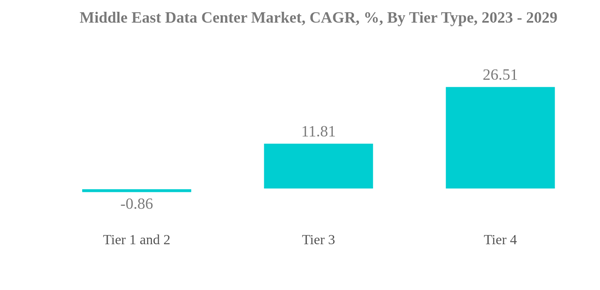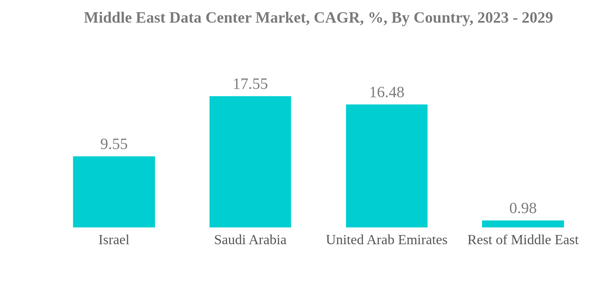The Middle East Data Center Market is projected to register a CAGR of 14.74%
Key Highlights
- IT Load Capacity: The IT load capacity of the data center market will have steady growth and is expected to achieve 2,059.5 MW by 2029.
- Raised Floor Space: The total raised floor area of the country is expected to increase to 9.7 million sq. ft by 2029.
- Installed Racks: The number of installed racks is expected to reach 496,769 units by 2029. Saudi Arabia is expected to house the maximum number of racks by 2029.
- DC Facilities: There are 128 colocation data center facilities in the Middle East. Saudi Arabia holds the highest share in the region. The development of fiber connectivity, increasing reliability in power supply, and high demand for data center services from end users are increasing DC construction in both developed and developing economies.
- Leading Market Player: Etihad Etisalat Company (Mobily) has the highest market share of 23.5% compared to its competitors in the data center market. The company currently operates at an IT load capacity of 168.3 MW and is expected to increase its capacity during the forecast period.
Middle East Data Center Market Trends
Tier 3 is the largest Tier Type
- The tier 3 segment currently holds the majority of the market share in the Middle East due to the significant advantages of its features. These tiers have a high level of redundancy and multiple power and cooling paths. The tier 3 data centers have an uptime of around 99.982%, resulting in 1.6 hours of downtime per year. With the increased adoption of edge and cloud connectivity, the tier 3 segment is expected to grow further.
- The tier 3 segment of the Middle Eastern market operated at an IT load capacity of 464.68 MW in 2022. During the forecast period (2022-2029), the IT load capacity is expected to grow from 621.78 MW in 2023 to 1,214.86 MW in 2029, with a CAGR of 11.81%.
- The tier 4 segment is expected to record the fastest CAGR of 26.51%. Several developing countries are focusing on getting Tier 4 certifications to benefit from complete fault tolerance and redundancy for all components. Due to such advantages, even developing countries are adopting tier 4 zones.
- The development of digital infrastructures such as data centers is required to implement 5G applications. More recently, the expansion of 24/7 business continuity services has increased the preference for tier 3 and 4 data centers due to the growing number of global companies. Data is an essential component of BFSI companies due to the stringent laws governing data storage and protection in the market. The BFSI sector is defined by digitalization. Due to the growing usage of various banking applications, data in the BFSI sector is growing exponentially.
Saudi Arabia is the largest Country
- In the coming years, the Middle East region is expected to increase its investment in the data center market. Several factors are facilitating the expansion of data centers in the area. The region's governments' smart city ambitions are driving a shift in how modern communities are built. Cities of the future, supported by digital technologies, are expected to generate massive amounts of data. It is critical to optimize data capture, storage, and processing.
- Domestic data growth and the emergence of 5G networks drive demand for localized data centers to speed up data transfer. Uncertain data sovereignty regulations in certain jurisdictions, including the GCC, drive data center investments. This emphasizes the importance of organizations such as banks retaining customer data within the country.
- The United Arab Emirates has been a prime location for data centers in the region as one of the frontrunners in the race to establish a robust and competitive digital economy. According to Arcadis' Data Centre Location Index, the UAE's "well-established fiber broadband network" helped the country secure the top spot for mobile broadband penetration. At the same time, the ease of obtaining construction permits and new smart city initiatives make it an emerging location for data center investment.
- Saudi Arabia launched a USD 18 billion strategy in July 2021 to establish a nationwide network of large-scale data centers. According to the Saudi Ministry of Communications and Information Technology, the first batch of investment partners includes local firms Gulf Data Hub, Al-Moammar Information Systems, and Saudi FAS Holding.
Middle East Data Center Industry Overview
The Middle East Data Center Market is moderately consolidated, with the top five companies occupying 55.91%. The major players in this market are Electronia, Etihad Etisalat Company (Mobily), Etisalat, Khazna Data Center and Med 1 I.C.-1 (1999) Ltd. (sorted alphabetically).Additional Benefits:
- The market estimate (ME) sheet in Excel format
- 3 months of analyst support
Table of Contents
1 EXECUTIVE SUMMARY & KEY FINDINGS2 REPORT OFFERS8 KEY STRATEGIC QUESTIONS FOR DATA CENTER CEOS
3 INTRODUCTION
4 MARKET OUTLOOK
5 KEY INDUSTRY TRENDS
6 MARKET SEGMENTATION
7 COMPETITIVE LANDSCAPE
9 APPENDIX
Companies Mentioned (Partial List)
A selection of companies mentioned in this report includes, but is not limited to:
- Bezeq International General Partner Ltd.
- Bynet Data Communications Ltd.
- EdgeConneX, Inc.
- Electronia
- Etihad Etisalat Company (Mobily)
- Etisalat
- Gulf Data Hub
- HostGee Cloud Hosting Inc.
- Injazat
- Khazna Data Center
- Med 1 I.C.-1 (1999) Ltd.
- MEEZA
Methodology

LOADING...










